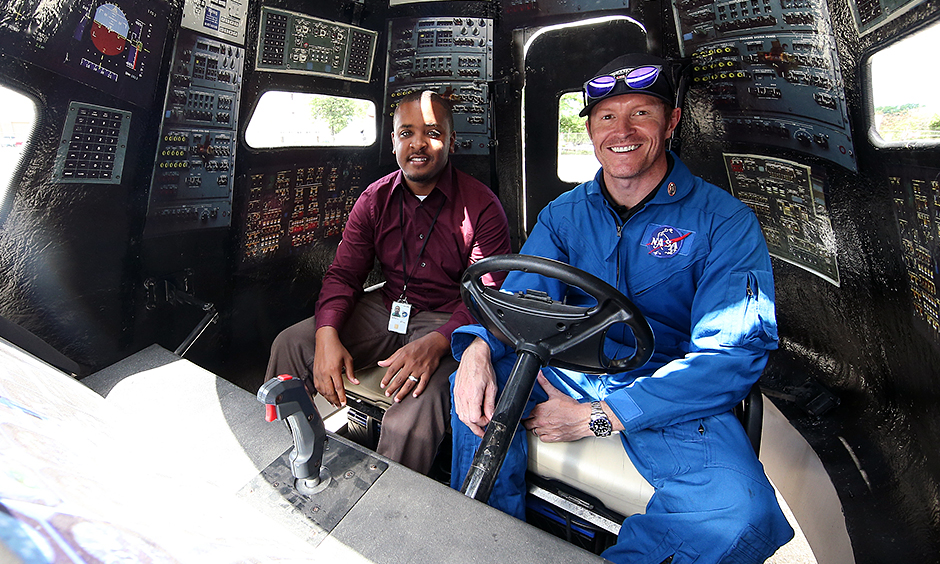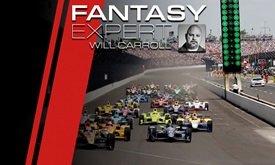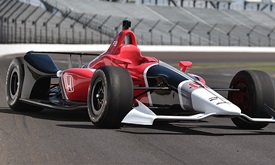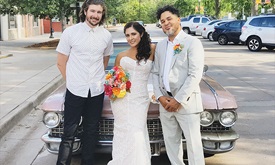NASA vehicle may not be fast, but Dixon, Norman enjoy going for spin
JUL 27, 2017
CLEVELAND — They looked the part of astronauts, decked out in blue NASA flight suits, as the curious inspection of the Mobile Orion Vehicle Explorer began.
Four-time Verizon IndyCar Series champion Scott Dixon of Chip Ganassi Racing and Indy Lights presented by Cooper Tires driver Ryan Norman of Andretti Autosport were ready to take for a spin this modular vehicle designed for use on the moon and hopefully Mars. (Click here for a photo gallery.)
The highlight of today's tour of NASA’s John H. Glenn Research Center for the racers, of course, was when they got the chance to drive.
“I can’t guarantee it will get you around the track as fast as your car,” David DeFelice, NASA’s community relations outreach head, said of the vehicle, called MOVE for short and with a maximum speed of 15 mph.
“We can still get in trouble at that,” Dixon said.
Norman, a 19-year-old native of Aurora, Ohio, southeast of Cleveland, climbed into the cockpit first, where he was shown the controls by outreach specialist Zach Lucas.
“Pretty insane. Fun,” Norman said, after one time around a concrete lot outside of an airplane hangar, at a significantly slower speed than he’s accustomed to in his race car. “A little bit of wheel spin.”
Then Dixon, the Verizon IndyCar Series points leader, took his turn and thoroughly enjoyed the test drive.
“I think we went about 300 or 400 mph,” he joked. “We were just sneaking up on it. Nothing too crazy, it handled well. I think the cool part with that is how confined it would be, sharing that with two or three other people.”
The experience provided a familiar feel for the drivers who this weekend will wear flame-retardant suits and climb into small cockpits to race at Mid-Ohio Sports Car Course, some 90 miles south in Lexington, Ohio. Norman will drive in two Indy Lights races this weekend while Dixon competes in the main event, the Honda Indy 200 for the Verizon IndyCar Series.
“We would be very suitable for piloting one of those things,” said Dixon. “We’re used to being in a tight space and going fast. It has a lot of similarities: speed and technology and always trying to push the envelope for making things better and lasting longer.
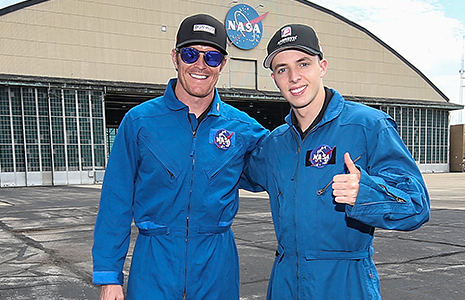 “The suit felt quite similar. The situation, you know in reality it’s totally different, but it has a lot of similarities. You’re putting on a fireproof suit and getting into a small cockpit. Obviously, you’d share that one a little bit whereas you don’t do that in our style of racing.”
“The suit felt quite similar. The situation, you know in reality it’s totally different, but it has a lot of similarities. You’re putting on a fireproof suit and getting into a small cockpit. Obviously, you’d share that one a little bit whereas you don’t do that in our style of racing.”
Dixon was so comfortable in his NASA flight suit, he didn’t want to take it off.
“I was trying to keep this thing,” he said with a smile while handing it back. “I wanted to see if I could get out of here with it.”
The center, established in 1942, designs and develops innovative technology to advance NASA’s missions in aeronautics and space exploration. One of 10 major NASA field centers, it includes 150 buildings on 350 acres with a highly skilled workforce of more than 3,000 scientists, engineers and technicians, along with administrative and support personnel focused on researching and testing game-changing technology in propulsion, aeronautics, materials and structures, communications, power and energy storage, and biomedical sciences.
A visit to the Simulated Lunar Operation (SLOPE) laboratory provided a look at special tires made with metal springs from steel and nickel titanium. Dixon took particular interest in the fact that the tires are so sturdy, they don’t need to be changed.
“Wow, that’s bad for business,” he said. “Firestone (exclusive tire supplier to the Verizon IndyCar Series) doesn’t want to see that.”
Damian Ludwiczak, branch chief, explained the need for tires that not filled with air for land travel on other spheres.
“When you go off the planet, we can’t have you stranded with a pneumatic rubber tire,” he said.
A remote-control Scarab lunar rover was situated on sand to simulate use on the moon. The top speed of the vehicle is less than 1 mph.
“It’s not about going fast,” explained Dr. Phillip B. Abel, deputy chief of the tribology and mechanical components branch. “It’s about getting there.”
“I’ll drive anything,” Dixon said.
Another popular visitor attraction is an Augmented Reality Sandbox, which uses infrared rays to form a three-dimensional topographic map in sand. When Dixon held his hand over the sand (photo below), rain was simulated on the surface. When his hand was lowered closer to the sand, the water formed waves.
The tour also included a visit inside a wind tunnel utilized for, among other things, advances in jet propulsion.
“As a kid, space is a big deal. Not in my era but especially in the ’60s, ‘70s, and ‘80s and ‘90s when it was very apparent,” Dixon said. “You always drew rockets when you were growing up. It’s a very prestigious line of work to be in. These are super-smart people trying to go beyond what’s previously ever been done.”
So, is Dixon, an Australian-born New Zealander, ready for a trip to the moon or Mars?
“That would be amazing to do that, there’s no doubt,” he said. “It’s very expensive. It’s more expensive than motor racing, that would be the problem.”
Dixon and the rest of the Verizon IndyCar Series drivers begin Honda Indy 200 at Mid-Ohio competition with a pair of practice sessions on Friday (10 a.m. and 2:15 p.m. ET). Both stream live on RaceControl.IndyCar.com.
Knockout qualifying to decide the Verizon P1 Award pole winner airs live at 2 p.m. Saturday on NBCSN. The 90-lap race on the 2.258-mile permanent road course begins with live coverage at 3 p.m. Sunday on CNBC and the Advance Auto Parts INDYCAR Radio Network. NBCSN has a race re-air at 7 p.m. Sunday.











